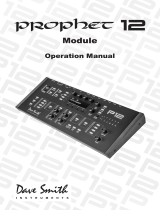
10
MIDI Note Output from the Arpeggiator and Sequencer
e Pro 3’s arpeggiator and sequencer both now output MIDI note numbers.
What was originally the setting in the menu in OS v1.0
is now called / and has been enhanced to include MIDI Note
output from Track 1 of the sequencer.
With this Global parameter enabled, any notes that you hold on the Pro 3
keyboard will be arpeggiated according to the current settings of the arpeggia-
tor and output over MIDI as MIDI notes. Similarly, any notes output by Track 1
(notes) of the sequencer will be output over MIDI as MIDI notes. You can use
this feature to drive other MIDI-equipped devices such as synthesizers and drum
machines.
To enable MIDI Note output from the arpeggiator and sequencer:
1. Press the button, then press So Button 2 to select the tab.
2. Use So Knob 1 to select / .
3. Turn So Knob 3 to select .
To control an external MIDI device:
1. Connect the MIDI or USB output of the Pro 3 to the MIDI or USB input
of the external device, depending on which type of connection the external
device requires.
2. On the Pro 3, press the button, then press So Button 2 to select the
tab
3. Use So Knob 1 to select .
4. Turn So Knob 3 to select , or , or +, depending on how
your Pro 3 and external device are connected.
5. Press the button again to exit the Global menu.
6. On the external device, set the the MIDI Channel and MIDI Receive port to
match the Pro 3.












